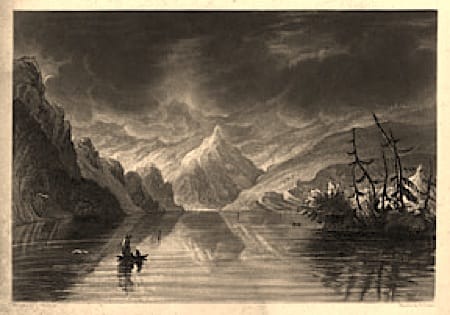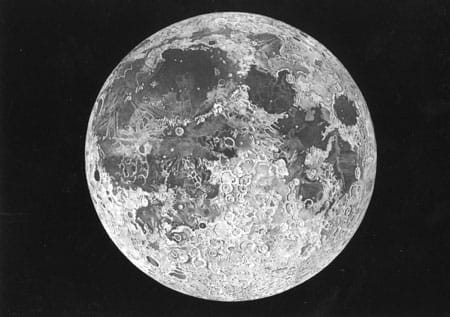Dear Artvehicle,
It seems right that this communiqué be presented in the spirit of a ‘postcard’, given its concern with disarticulations between outward travel and return, and the associated risk that what is sent out might never come back. A postcard itself can be a compound of contradictions, a mixture of extraneous measures (images incommensurate with a source point; arriving out of kilter with the sequence of travel, etc.) and precise indexes (i.e. the postmark). As both its form and passage can instigate or be provoked by potential disruption, it seems the perfect vehicle to address concerns for the vulnerabilities and sufferings of communication, and the press of both proximity and distance.
Another unreliable source point for this postcard are the three exhibitions that have opened simultaneously at Modern Art Oxford [Katie Paterson – Encounters; Ansel Adams – Photographs; Mircea Cantor – The Need for Uncertainty, all at Modern Art Oxford from 2nd April to 1st June 2008] – the details and discrepancies amongst them provoking uncertainties as to their common orbits and their shared movements in and out of coherence. In the Lower Gallery, a space crowded by a low ceiling and wide white columns, the artist Katie Paterson has installed Earth-Moon-Earth (Moonlight Sonata Reflected from the Surface of the Moon), a work made in 2007. A player piano clinically performs Beethoven’s famous piece, yet the playback is subtly disrupted, made strange, with a degree of alienation that is difficult to gauge. The insertion of immense physical distance into the structure of the music – the score, translated into Morse code, has been reflected off the lunar surface using the techniques of early radio broadcasting (also known as ‘moon bounce’) alluded to in the title, then subsequently decoded back on earth and performed in its ‘moon altered’ state – nonetheless operates on an extremely delicate scale. At times everything seems intact. At others, the degree of discrepancy between the original and the ‘processed’ music hovers at the edges of audibility. At still others there are brutal inconsistencies – tones are awkwardly clipped or vanished completely; intervals become elongated into rests, gradually approaching an uncertain territory of cumulative inconsistency, a region of hesitation without coordinates.
The effect becomes increasingly unnerving, as if one were listening to the sound of a system unpredictably self-destructing, corroded by an unknown number of gaps and glitches. The effect of the cancellations, strewn throughout the score like random, inverted code, seems to threaten total cessation, hovering at the abyss like a sufferer of sleep apnoea. What gradually to come to the fore is the presence of that cancelling out – the cadences of the missing gain materiality, the erasures beginning to resemble the black bands of the censor, granting shape and undeniable (yet deferred) availability to what is concealed. The intervention of the signal begins to assume a ‘body’, accompanying the original like the gaze of a passive satellite. The Morse signal is partially absorbed by the lunar surface – fragments of it are lost to shadow or smothered by craters. The moon’s low albedo (from the Latin albus – ‘white’), a measure of its reflectivity or the extent to which it diffusely reflects sunlight, contributes to this ‘path loss’, together with the complexities that make up its dusty, scattering surface.
The moon’s capacity as an agent of disruption and the status of its interventions seems curiously related to creative work, and the necessary risks and separations involved in the propagation and development of ideas. In relation to Paterson’s installation, the lunar surface would seem to be the ultimate surface of uncertainty, doubt and disarticulation. It mutely offers recourse for ‘earthbound’ systems of thought and organisation, perhaps providing a way to bring down, to let slip, in a manner similar to that of Georges Bataille’s notion of the informé. As such, going to the moon would constitute an operation, a process of admitting and inhabiting doubt, opening up to its formless contamination. It seems fitting to note that the moon’s surface was initially considered so uncertain that there were fears that the Apollo lunar module would sink from sight on touchdown. Such a surface – such a face – is a paradox of the familiar and the strange, at once pressingly proximate and maddeningly distant, forever giving, but giving nothing away. It is a surface deprived of secret, yet without depth, withholding an enigmatic capacity for transformation in spite of this.
The necessity of relinquishment in creative work, as well as the constant accompanying presence of untraceable lack – a satellite of unwork orbiting every endeavour – seems to be touched upon here. To throw practice to the limits of orbit, toward its dissolution (though not beyond escape velocity, lest it be lost to the chaos of the outer reaches, never to return), is to vicariously extend process into a zone where one cannot go – taking a draft of the underworld, perhaps without the need for averting the eyes. Deflecting off the moon, in this sense, is a logical, albeit extreme, process of complication – an outsourcing of work to the most ubiquitous (isolated and unknowable) of third party assistants. Such a gesture of exposure, not only to disruption but annihilation, might be considered symptomatic of the artistic encounter with chaos – uncertain points of contact at the edges of the atmosphere. Inherent in this risk is the demand that communication fail, or at least to be damaged by its own occurrence – to be marked by it.
Considering its role as a processing filter, or sounding board to make strange, the moon surface is positioned between absorption and reflection, ‘preferring’ neither to fully retain or faithfully copy and bounce back. It remains an object of passivity, a Bartleby – a disruptive presence that contaminates the signals it receives by virtue of its brute presence. The surface itself is consonant with a recording device, in what would appear to be the perfect conditions. It is something like a writing tablet, possessed with an immense capacity for inscription, which still betrays fateful flaws in its powers of capture and transmission. It is resigned to faithfully record and display relentless impacts, whether from micrometeoroids to radio signals, and the relentlessly visible suffering has transformed the façade into a glass of agglutinates. The regolith (Greek for ‘blanket rock’) is perfectly suited to the recording of traces, the dust basins like planes of memory in a inert atmosphere of preservation, yet remains subject to the self-erasing inconsistencies of surface and the constant risk of further modulation from outside – recording-over.
Going back to Paterson’s installation, it is worth nothing that Beethoven’s piano sonata (No.14 in C-Sharp minor, Op.27, No.2) was given the assignation of ‘Moonlight’ in 1832 by the music critic Ludwig Rellstab, referring to his observation of moonlight shining on the surface of Lake Lucerne. This seems another interesting reference, as if we might compare two opposing surfaces and their shifting capacities for fidelity and disruption, between direct reflection and chaotic diffraction. What might we make of Lake Lucerne as a reflective surface or recording device? What coincidences of angle might conspire to silence on those waters? Comparisons might be drawn between the striated and the potentially smooth, or between uncomplicated reversals and repetitions – a mirror surface facing the scrambling regolith and ideas moving back and forth between water and rock.
Other associations come to mind in relation to the otherness of the satellite surface, its configurations operating in proximity to the impossible, subject to demands radically different to whatever signal might be received or sent back. A 19th Century etching by the artist John Russell shows the whole visible surface of the moon “impossibly lit” – an artificial light source, impossible in reality, slants in obliquely, allowing him to emphasise surface texture in a way that would not normally be visible. Russell’s ‘oblique’ vantage, with light reflecting off the moon at an angle, results in an image that is equally unnerving, this time due to excess rather than lack. The artificial consistency of focus and the uniformity of the shadows, results in a curiously passive image, a clinical reproduction (in some ways as mechanical as any translation back and forth into code) that deadens the messy lunar surface with its own detail. The impervious otherness of this ultimate uncertain surface reappeared in the exhibition of photographs of Ansel Adams, also at Modern Art Oxford, predominantly made up of images made as part of a government commission to record the North American National Parks in the 1940s. Amongst dozens of images of monumental landscapes, ‘Moonrise’ includes a chalky lunar disc that, given its relatively small scale in the composition and its suspension in the metallic sheen of Adams’ technique, appears like a shark’s eye – deader than ever. The frozen moon seemed exposed, as if caught in a state of undress, belittled by the monochromatic myth making of Adams’ America. Like a flaw in the firmament, a shameful chip of bone showing through grazed skin, uncertainty shows through, like an escape valve in the midst of the photographer’s work, as if it all could come undone at any moment.
Although there are no moons in his installation, Romanian artist Mircea Cantor’s The Need for Uncertainty again seemed vitally linked to reflections between uncertain surfaces. His work uneasily juxtaposes elements that simultaneously produce sparks in of friction and cancel each other out. The individual components of this latest work, commissioned for the large Upper Gallery, seemed to cohabit the space like loosely related components of an absent assemblage – exhibits of minor, tangential culture on the verge of being forgotten. The missing ‘system’ of which the components might silently speak seems to suggest not simply nested realities, but lost worlds within lost worlds, each with their own uncertain intensities of gravity positioning them in relation to the every other. In the corner of the space, Cantor has placed a set of three nested cages (containing a pair of peafowl) around which the audience orbits, at the boundary of another cautious, viscous gravitation. The vertical bars of the cages are recalled in a colour photograph on the adjacent wall, apparently showing a section of Romanian forest in which one of the trees has had its trunk carved into, forming a strange geometric shape – most interestingly using the tree’s own ‘flesh’ to create the symbol, which resembles an angular star or a mock shell blast, weakening and reinforcing the trunk simultaneously. The third element of the installation, a flying carpet, hovers above all other components as if overseeing them. Decorated with silhouettes of military jets and blocky angels, the ambivalent symbolism of the pattern design seems, like the rest of the constellation if forms part of, to remain both simple and strange. The details of the exchanges between the objects and images remains partially unexplained, insistent as to this implied absence. Worlds within worlds can exist worlds apart, as if a silent partner, a satellite accompaniment, were attending each association and inserting an incommensurable and deadening distance, like that between the earth and the moon.
Katie Paterson – Encounters, Ansel Adams – Photographs, Mircea Cantor – The Need for Uncertainty At Modern Art Oxford
www.modernartoxford.org.uk
David Stent

Lake of Lucerne - London: John Dennis, 1820. Aquatint in sepia ink. Engraved by Thomas Lupton
http://www.art-books.com/artbooks/images/items/59-0308.jpg

John Russell, R.A. Engraving of the moon, showing the ‘impossible’ image of the whole visible surface of the moon illuminated obliquely, published posthumously in 1806
Scanned from a postcard from the Museum of the History of Science, Oxford www.mhs.ox.ac.uk